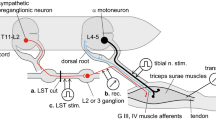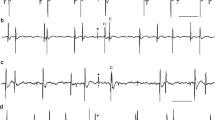Summary
We examined modulation of transmission of short-latency excitation produced by distal hindlimb cutaneous input, as well as fluctuations in motoneuron membrane potential and input resistance, in flexor digitorum longus (FDL) motoneurons during fictive locomotion. Fictive stepping was induced in unaesthetized, decerebrate cats either by repetitive stimulation of the mesencephalic locomotor region (MLR) or by administration of Nialamide and 1 DOPA after low spinal section. In the MLR preparations, brief depolarizing waves occurred in FDL cells during the early flexion phase of fictive stepping, immediately after cessation of activity in extensor muscles. In some FDL cells, plateau-like depolarizations also occurred during the extensor phase. Fictive stepping induced in acutely spinalized cats by administration of l-DOPA was slower and more variable; peak polarization in FDL motoneurons always occurred during the early flexion phase but there was usually no distinct depolarization during extension. In both types of preparation, the initial EPSP components in synaptic potentials (SP-EPSPs) produced by electrical stimulation of the cutaneous division of the superficial peroneal nerve (SP) were maximally facilitated during early flexion, coincident with the peak of background depolarization. This enhancement was manifested by an increase in the amplitude of initial SP-EPSP components or by decreased central latency of the initial EPSP components, or both. In most FDL motoneurons, input resistance decreased systematically during late flexion, coincident with relative membrane hyperpolarization. Correction of SP-EPSP amplitudes for changes in input resistance suggested that SP-EPSP facilitation persisted throughout the flexion phase These findings are discussed with reference to modulation of cutaneous reflexes during locomotion and the possibility that excitatory last-order interneurons in particular cutaneous reflex pathways may distribute excitatory drive from the central pattern generator for locomotion to FDL α-motoneurons
Similar content being viewed by others
References
Abraham LD, Marks WB, Loeb GE (1985) The distal handlimb musculature of the cat: cutaneous reflexes during locomotion. Exp Brain Res 58: 594–603
Anderson O, Forssberg H, Grillner S, Lindquist M (1978) Phasic gain control of the transmission in cutaneous reflex pathways to motoneurones during “fictive” locomotion. Brain Res 149: 503–507
Arshavsky YuI, Berkinblit MB, Fukson OI, Gel'fand IM, Orlovsky GN (1972a) Recordings of neurones of the dorsal spinocerebellar tract during evoked locomotion. Brain Res 43: 272–275
Arshavsky YuI, Berkinblit MB, Fukson OI, Gel'fand IM, Orlovsky GN (1972b) Origin of modulation in neurones of the ventral spinocerebellar tract during locomotion. Brain Res 43: 276–279
Baldissera F, Hultborn H, Illert M (1981) Integration in spinal neuronal systems. In: Brooks VB (ed) Handbook of physiology, Sect 1 The nervous system, Vol II. Motor control, Part 1. American Physiological Society, Bethesda, Md., pp 509–595
Bayev KV, Kostyuk PG (1982) Polarization of primary afferent terminals of lumbosacral cord elicited by the activity of spinal locomotor generator. Neuroscience 7: 1401–1409
Burke RE, Fleshman JW (1986) Strategies to identify interneurons involved in locomotor pattern generation in the mammalian spinal cord. In: Grillner S, Stein PSG, Stuart DG, Herman R (eds) Neurobiology of vertebrate locomotion: Wenner-Gren Center International Symposium, Vol 45. Macmillan, London, pp 245–268
Burke RE, Fedina L, Lundberg A (1971) Spatial synaptic distribution of recurrent and group Ia inhibitory systems in cat spinal motoneurones. J Physiol (Lond) 214: 304–326
Dubuc R, Cabelguen J-M, Rossignol S (1985) Rhythmic antidromic discharges of single primary afferents recorded in cut dorsal root filaments during locomotion in the cat. Brain Res 359: 375–378
Duysens J (1977) Reflex control of locomotion as revealed by stimulation of cutaneous afferents in spontaneously walking premammillary cats. J Neurophysiol 40: 737–751
Duysens J, Loeb GE (1980) Modulation of ipsi and- contralateral reflex responses in unrestrained walking cats. J Neurophysiol 44: 1024–1037
Duysens J, Pearson KG (1976) The role of cutaneous afferents from the distal hindlimb in the regulation of the step cycle of thalamic cats. Exp Brain Res 24: 245–255
Duysens J, Stein RB (1978) Reflexes induced by nerve stimulation in walking cats with implanted cuff electrodes. Exp Brain Res 32: 213–224
Edgerton VR, Grillner S, Sjostrom A, Zangger P (1976) Central generation of locomotion in vertebrates. In: Herman RM, Grillner S, Stein PSG, Stuart DG (eds) Neural control of locomotion. Plenum Press, New York, pp 439–464
Chandler SH, Baker LL, Goldberg LJ (1984) Characterization of synaptic potentials in hindlimb motoneurons during 1-DOPA-induced fictive locomotion in acute and chronic spinal cats. Brain Res 303: 91–100
Deliagina TG, Orlovsky GN, Pavlova GA (1983) The capacity for generation of rhythmic oscillations is distributed in the lumbosacral spinal cord of the cat. Exp Brain Res 53: 81–90
Feldman AG, Orlovsky GN (1975) Activity of interneurons mediating reciprocal Ia inhibition during locomotion. Brain Res 84: 181–194
Fleshman JW, Lev-Tov A, Burke RE (1984) Peripheral and central control of flexor digitorum longus and flexor hallucis longus motoneurons: the synaptic basis of functional diversity. Exp Brain Res 54: 133–149
Fleshman JW, Rudomin P, Burke RE (1988) Supraspinal control of a short-latency cutaneous pathway to hindlimb motoneurons. Exp Brain Res (in press)
Forssberg H (1979) Stumbling corrective reaction: a phase-dependent compensatory reaction during locomotion. J Neurophysiol 42: 936–953
Forssberg H, Grillner S, Rossignol S (1975) Phase dependent reflex reversal during walking in chronic spinal cats. Brain Res 85: 103–107
Forssberg H, Grillner S, Rossignol S (1977) Phasic gain control of reflexes from the dorsum of the paw during spinal locomotion. Brain Res 132: 121–139
Gossard JP, Cabelguen JM, Saltiel P, Drew T, Rossignol S (1987) Rhythmic modulation of cutaneous afferent membrane potential during fictive locomotion in the cat. Soc Neurosci Abstr 13: 1175
Grillner S (1981) Control of locomotion in biped, tetrapods, and fish. In: Brooks VB (ed) Handbook of physiology, Sect 1. The nervous system, Vol II. Motor control, Part 2. American Physiological Society, Bethesda, Md., pp 1179–1236
Grillner S, Shik ML (1973) On the descending control of the lumbosacral spinal cord from the “mesencephalic locomotor region”. Acta Physiol Scand 87: 320–333
Grillner S, Zangger P (1974) Locomotor movements generated by the deafferented spinal cord. Acta Physiol Scand 91: 38a-39a
Grillner S, Zangger P (1979) On the central generation of locomotion in the low spinal cat. Exp Brain Res 34: 241–261
Jankowska E, Jukes MGM, Lund S, Lundberg A (1967) The effects of dopa on the spinal cord. 5. Reciprocal organization of pathways transmitting excitatory action to alpha motoneurones of flexors and extensors. Acta Physiol Scand 70: 369–388
Jordan LM (1983) Factors determining motoneuron rhythmicity during fictive locomotion. Soc Exp Biol Symp 37: 423–444
Kniffki KD, Schomburg ED, Steffens H (1981) Effects from fine muscle and cutaneous afferents on spinal locomotion in cats. J Physiol (Lond) 319: 543–554
Loeb GE, Marks WB, Hoffer JA (1987) Cat hindlimb motoneurons during locomotion. IV. Participation in cutaneous reflexes. J Neurophysiol 57: 563–573
Lundberg A (1969) Convergence of excitatory and inhibitory action on interneurones in the spinal cord. In: Brazier MAB (ed) The Interneuron. UCLA Forum in Medical Sciences. University of California, Berkerly, CA, pp 231–265
Lundberg A (1975) Control of spinal mechanisms from the brain. In: Brady RO (ed) The nervous system, Vol 1. The basic neurosciences. Raven Press, New York, pp 253–265
O'Donovan MJ, Pinter MJ, Dum RP, Burke RE (1982) Actions of FDL and FHL muscles in intact cats: functional dissociation between anatomical synergists. J Neurophysiol 47: 1126–1143
Omeniuk DJ, Schmidt BJ, Burke RE (1986) Central latencies of PSPs evoked by low threshold cutaneous afferents in cat α-motoneurons. Soc Neurosci Abstr 12: 70.6
Orsal D, Perret C, Cabelguen J-M (1986) Evidence of rhythmic inhibitory synaptic influences in hindlimb motoneurons during fictive locomotion in the thalamic cat. Exp Brain Res 64: 217–224
Orlovskii GN, Fel'dman AG (1972) Classification of lumbosacral neurons by their discharge patterns during evoked locomotion. Neirofiziologiya 4: 410–417
Perret C, Cabelguen J-M (1980) Main characteristics of the hindlimb locomotor cycle in the decorticate cat with special reference to bifunctional muscles. Brain Res 187: 333–352
Pratt CA, Jordan L (1987) Ia inhibitory interneurons and Renshaw cells as contributors to the spinal mechanisms of fictive locomotion. J Neurophysiol 57: 56–71
Rall W (1967) Distinguishing theoretical synaptic potentials computed for different soma-dendritic distributions of synaptic input. J Neurophysiol 30: 1138–1168
Rall W, Burke RE, Smith TG, Nelson PG, Frank K (1967) Dendritic location of synapses and possible mechanisms for the monosynaptic EPSP in motoneurons. J Neurophysiol 30: 1169–1193
Rossignol S, Julien C, Gauthier L (1981) Stimulus-response relationships during locomotion. Can J Physiol Pharmacol 59: 667–674
Schmidt EM (1982) Computer control of the Nicolet 1170 signal averager. J Neurosci Methods 6: 273–279
Schmidt BJ, Meyers DER, Tokuriki M, Fleshman JW, Burke RE (1986) Modulation of short latency EPSPs from cutaneous afferents to FDL motoneurons during fictive locomotion in the cat. Soc Neurosci Abstr 12: 242.9
Schmidt BJ, Meyers DER, Tokuriki M, Fleshman JW, Burke RE (1987) Modulation of short latency cutaneous excitation in flexor and extensor motoneurons during fictive locomotion in the cat. Soc Neurosci Abstr 13: 826
Schomburg ED, Behrends HB (1978a) Phasic control of the transmission in the excitatory and inhibitory reflex pathways from cutaneous afferents to alpha-motoneurons during fictive locomotion in cats. Neurosci Lett 8: 277–282
Schomburg ED, Behrends HB, Steffens H (1978b) Alteration of transmission in segmental pathways from flexor reflex afferents (FRA) to alpha-motoneurons during spinal locomotor activity. Neurosci Lett [Suppl] 1: s103
Schomburg ED, Behrends HB, Steffens H (1981) Changes in segmental and propriospinal reflex pathways during spinal locomotion. In: Taylor A, Prochazka A (eds) Muscle receptors and movement. MacMillan, London, pp 413–425
Shefchyk SJ, Jordan LM (1985a) Motoneuron input-resistance changes during fictive locomotion produced by stimulation of the mesencephalic locomotor region. J Neurophysiol 54: 1101–1108
Shefchyk SJ, Jordan LM (1985b) Excitatory and inhibitory post-synaptic potentials in α-motoneurons produced during fictive locomotion by stimulation of the mesencephalic locomotor region. J Neurophysiol 53: 1345–1355
Shik ML, Orlovsky GN (1976) Neurophysiology of locomotor automatism. Physiol Rev 56: 465–501
Shik ML, Severin FV, Orlovsky GN (1966) Control of walking and running by means of electrical stimulation of the midbrain. Biophysics 11: 756–765
Smith TG, Wuerker RB, Frank K (1967) Membrane impedance changes during synaptic transmission in cat spinal motoneurons. J Neurophysiol 30: 1072–1096
Zar JH (1984) Biostatistical analysis. Prentice-Hall, Englewood Cliffs, NJ
Author information
Authors and Affiliations
Rights and permissions
About this article
Cite this article
Schmidt, B.J., Meyers, D.E.R., Fleshman, J.W. et al. Phasic modulation of short latency cutaneous excitation in flexor digitorum longus motoneurons during fictive locomotion. Exp Brain Res 71, 568–578 (1988). https://doi.org/10.1007/BF00248749
Received:
Accepted:
Issue Date:
DOI: https://doi.org/10.1007/BF00248749




